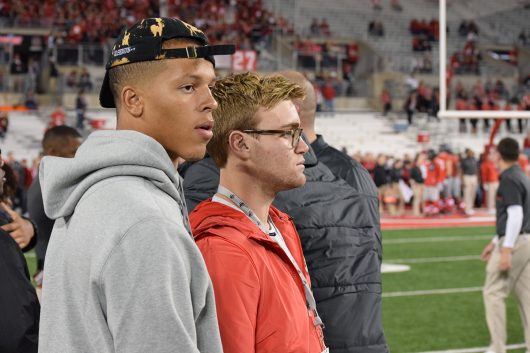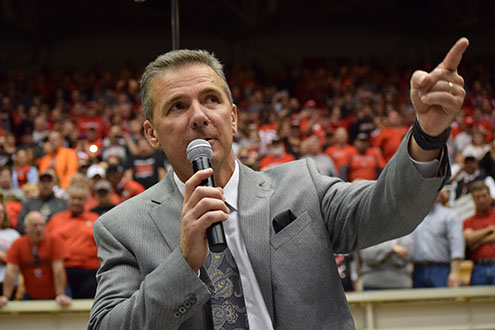
OSU recruits Trevon Grimes and Tyjon Lindsey visited Columbus for the OSU vs. Nebraska football game on Nov. 5. Lindsey has since decommitted. Credit: Giustino Bovenzi
On Nov. 5, the Ohio State Buckeyes were getting ready to take on the Nebraska Cornhuskers for an 8 p.m. showdown in Columbus.
Not only were these two teams slugging it out to continue the quest for a national championship, but this game served as a massive recruiting battle for the Buckeyes.
More than 20 four- and five-star high-school recruits paid visits, both official and unofficial, to Ohio Stadium to decide whether to commit to the Buckeyes.
After the Buckeyes destroyed the Cornhuskers 62-3, recruits met with Urban Meyer and took pictures with their potential jersey numbers to cap off OSU’s full-on press to sway some of the nation’s top talent.
Meyer often refers to recruiting as the “lifeblood of the program.” But how much money is spent to acquire that lifeblood?
In a months-long project, The Lantern analyzed how much money was spent on recruiting by OSU and the rest of the Big Ten Conference.
As the Big Ten team with the most wins and only football national championship in the past four years, the numbers show the Buckeyes spend, on average, on pace in comparison to the other schools in the Big Ten.
Records show OSU spent just over $2 million on recruiting from 2012 to 2015. Though that might seem like a lot, other schools spent more.
The Big Ten’s biggest spender, Nebraska, spent $3.46 million to expand its recruiting reach.
The lowest-spending team, the Wisconsin Badgers, spent just $1.02 million.
When you break down OSU’s $2.009 million, it averages out to $502,439 per year from 2012 to 2015.
Divide spending by wins, and OSU spent $40,423 per win, giving them the second-lowest cost per win (CPW) rate in the conference.

Bubba Bolden (left) and Tate Martell (right) visit Columbus for the OSU vs. Nebraska game on Nov. 5. Bolden has since committed to USC. Credit: Giustino Bovenzi
“I don’t know what other people spend money on, but we’re really financially conscious just because one: There’s no need to be frivolous with money, and two: That’s something you want to do for your administration, for your athletic director,” OSU wide receivers coach Zach Smith said. “We don’t take first- class flights, we don’t stay in $400-a-night hotels, and I don’t know if that’s what they spend money on, but we’re real conscious because there’s no need for that. We’re just trying to do a job, and we have whatever we need to do that job.
After analyzing yearly NCAA membership financial reports from fiscal 2012 to 2015, and conducting interviews with Big Ten officials, The Lantern also found that recruitment spending in the Big Ten rises each year.
The findings were calculated from NCAA financial membership reports that detail each school’s complete financial budget for fiscal years 2012, 2013, 2014 and 2015. Some universities, like Penn State, post financial records online.
Thirteen of the 14 members of the Big Ten provided data, while Northwestern University, a private institution, declined to participate. The university is not subject to open-records laws that apply to public schools.
Since 2012, recruiting spending across the Big Ten increased 39 percent.
That spending commitment by conference teams has amounted to more wins for some schools in the past four seasons.
One might think spending money on recruiting is an easy way for a football program to improve its record. But, as the data shows, spending on recruiting doesn’t always result in wins.
After coach Urban Meyer took over in Columbus at the end of 2011, the Buckeyes spent $344,987 in 2012. That number grew to $614,619 in three years, showing a 78 percent increase. This is the third-highest rise in the conference during that time, behind only Penn State and Rutgers.
OSU officials turned down a request to speak with Meyer about the commitment to recruiting, saying that he would be unavailable to speak to such topics during football season.
OSU Vice President and Athletic Director Gene Smith backed the Buckeyes’ spending increases, explaining why there has been a drastic change over the past four years.
“We always invest in what is necessary to be successful and recruiting is a part of that,” Gene Smith said in an email. He added that rising travel costs and “hosting expenses” explain the conference’s 39 percent rise in spending.
The NCAA does not impose financial limits on how much a university can spend on recruiting. However, spending is limited to the following expenses: travel and lodging for coaches, travel and lodging (coach class airfare and a standard hotel room) for prospects and their parents on official visits, reasonable entertainment expenses (including three tickets to a home sporting event) and up to three meals per day for the prospect and his parents for football recruits.
Additionally, there are strict restrictions on the timeframe when a recruit can be contacted by coaches. A full breakdown of recruiting rules and a yearly recruiting calendar can be found on the NCAA website.
Smith said these comparisons are like comparing apples to oranges, because, geographically speaking, it’s easier for OSU and more centrally located schools to recruit nationally than it is for a school in the more rural parts of the country.
“What it costs OSU to recruit in our geography compared to what it costs Nebraska from Lincoln (Nebraska) or Penn State from Happy Valley (Pennsylvania) is totally different,” Smith said. “Planes, gas, meals per diet regulations, etc., are all different.”
Smith’s explanation provided reasoning why the Cornhuskers, the conference’s highest spending team, spent nearly $3.5 million on recruiting.
Since Lincoln, Nebraska, is the westernmost school in the conference, it costs more to bring in recruits for official visits and fly out to evaluate potential players.
John Jentz, executive associate athletic director and CFO at Nebraska, confirmed travel as the main driver for higher costs.
“We have made a conscious investment in expanding our reach to find the best matches for our program,” Jentz said. “(In Nebraska) we like to say, ‘We are in the middle of everywhere,’ but few of those everywheres are reachable by car.”
Nebraska’s 34 wins in the Big Ten since 2012 makes it fourth-best in the conference, but its $886,819 spending average makes for a $107,998 CPW average, which is the fourth-highest in this study. Despite the high numbers, Jentz maintained Nebraska’s dedication to improve the football program.
“There is a recruiting budget established for each sport, each year,” Jentz said. “But if circumstances dictate more resources are needed for recruiting, we encourage identifying savings elsewhere to ensure success in recruiting.”
The Cornhuskers are narrowly followed by the Penn State Nittany Lions, who spent a total of $3.441 million on recruiting over the four-year period. In fact, Penn State spent $1.391 million on recruiting in 2014 alone, the highest of any school in the Big Ten from 2012 to 2015.

OSU coach Urban Meyer addresses the crowd at a Skull Session prior to OSU’s game against Nebraska on Nov. 5. Credit: Giustino Bonvenzi
Penn State’s increased spending is explained by other circumstances. Specifically, 2012 was the first year of NCAA-imposed sanctions from the child sexual abuse scandal involving former assistant coach Jerry Sandusky.
The number of scholarships dropped from 85 to 65 before the sanctions were gradually, and eventually, lifted. Despite the fact that traveling in general was reduced by the scholarship restrictions, selling a rebounding program to potential recruits is not an easy task.
The team that spent the most on recruiting per win was the Purdue Boilermakers. With only 12 wins during four years, their relatively frugal spending on recruiting flips into a $238,795 CPW.
These numbers also show how each team has a different philosophy when it comes to recruiting. For instance, Wisconsin tallied the second-most wins with 38 in the Big Ten through the 2012-2015 seasons. The Badgers spent $256,080 on average for recruiting, making its $26,940 CPW the lowest in the Big Ten.
Wisconsin Athletics Director Barry Alvarez was unavailable for comment.
Since accepting the job as the Buckeyes head coach, Urban Meyer has amassed 50 wins in his first four seasons. The Big Ten historically has been a conference that sticks to recruiting the Midwest. Meyer expanded the program’s reach across the country.
OSU redshirt junior quarterback J.T. Barrett, a Wichita Falls, Texas, native, hoped to be recruited by the University of Texas, but never got the call from former coach Mack Brown and the Longhorns. Barrett was then lured to Columbus by then-OSU offensive coordinator, now Longhorns coach, Tom Herman.
Meyer openly speaks of how Barrett’s recruitment was unorthodox, admitting that Barrett was the first quarterback prospect he’s ever offered a scholarship without seeing him throw. Statistically speaking, Barrett is among one of the greatest quarterbacks in Buckeye history.
A RECRUITING STIGMA
Recruiting spending is a not topic athletic departments usually discuss with media outlets, partly because a recruiting violation could be uncovered. Think of Reggie Bush accepting benefits at USC, or “Tattoo-Gate” at OSU. In Bush’s case, the violations caused severe penalties for the Trojans, who then had to vacate numerous wins, including their 2004 National Championship and Bush’s Heisman Trophy.
A more recent example comes from just last year before the 2016 NFL draft. Top prospect Laremy Tunsil of Ole Miss was outed by his stepfather, who released a bong mask video via Instagram. The hacked account also leaked screenshots of text conversations with a coach that detailed pay for Tunsil’s rent and his mother’s utilities.
Tunsil later admitted to accepting illegal benefits during his playing days after he was drafted No. 13 overall by the Miami Dolphins.
Most of the data the 13 participating schools provided was fiscal year figures that are reported as a lump sum of recruiting spending.
Ohio State provided an additional report with more in-depth explanation of its recruiting spending, including a ledger of coaches’ traveling expenses.
The detailed data showed expenditures from Meyer and nearly all of his assistants. The data was clean as far as showing any wrongdoings by the program, but maintaining this detailed data set does have its complications.
OSU Athletics Chief Financial Officer Joe Odoguardi said OSU is working to create a newer and better system.
“Right now we’re in the process of getting a new travel system that would allow us to (analyze) something like this better electronically, but unfortunately it’s being developed in-house and it’s been delayed for numerous reasons that are too long to explain,” Odoguardi said. “Once something like that is developed, something like this will be a lot easier to produce.”



